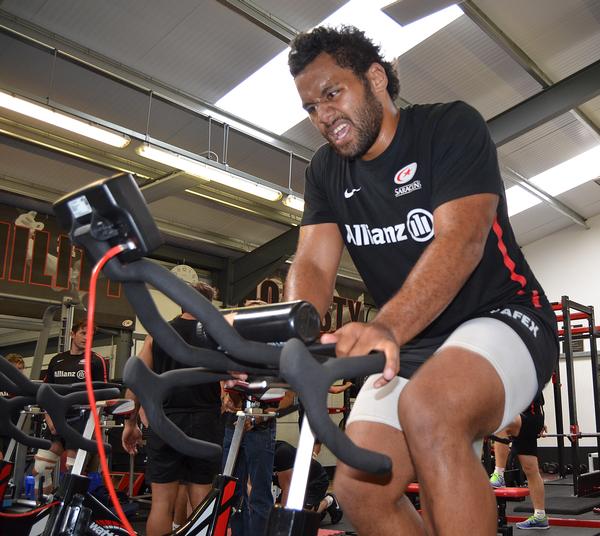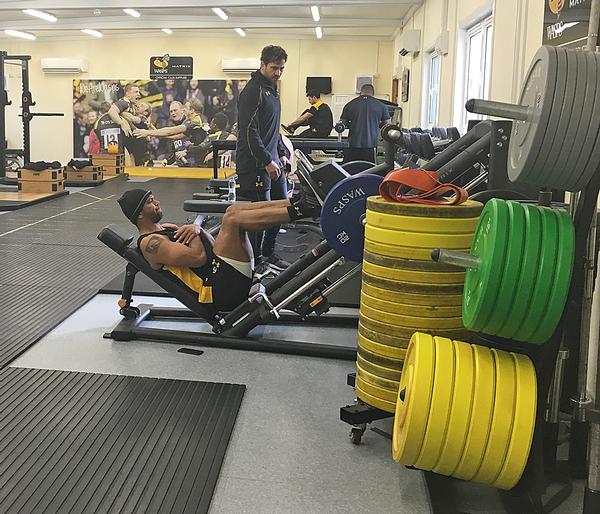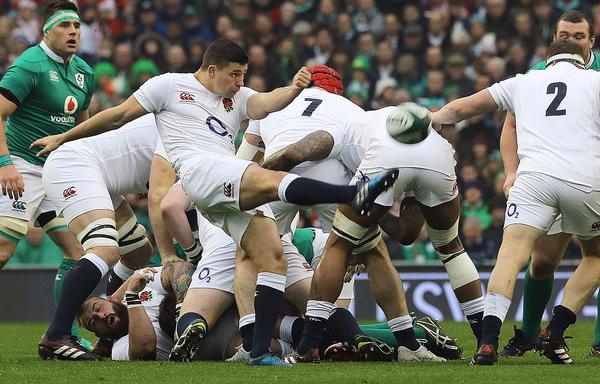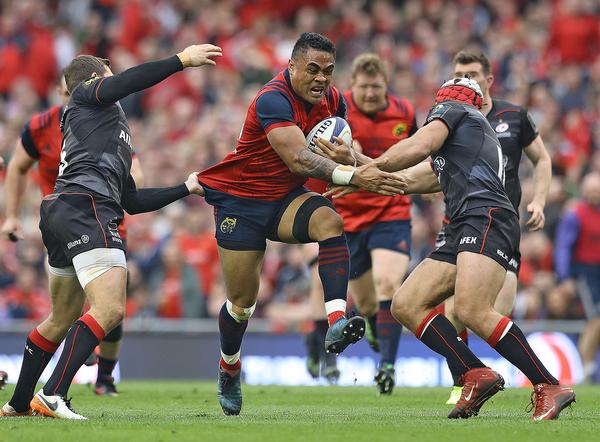 SELECTED
ISSUE
SELECTED
ISSUE
|
|
Leisure Management - Rugby Training

Sports conditioning

|
|
| Rugby Training
|

How do different rugby teams train their players for maximum strength, speed and agility? Tom Walker talks to three clubs about their approaches
Tom Walker, Leisure Media
|

Cardio is a big part of Billy Vunipola from Saracens’ workout
|
|
|
Rugby is a multi-faceted contact sport, requiring an abundance of physical attributes. As a result, the training routines of rugby players are acknowledged to be very physical and high in intensity – among the toughest of any sport. “Speaking plainly, most professional rugby players these days need to target strength, muscle mass, anaerobic and aerobic power, speed, flexibility and movement proficiency,” says Trystan Bevan, performance coordinator at Wasps Rugby. Former England rugby star and current Harlequins forwards coach Graham Rowntree adds that the task for the sports conditioning team is simple, yet demanding. “In rugby, it’s all about repeated power outputs and being able to hold intensity into the 80th minute of a game,” he says. So how do rugby clubs and teams ensure that their players achieve the standards required by the modern professional game? What kind of equipment do they use to hone physical fitness? Sports Management takes a closer look.
|
|

|
Club: Wasps
Supplier: Matrix
When Aviva Premiership rugby club Wasps was looking to create and fit out a new conditioning gym, it had to consider the various demands placed on the facility. “In deciding which pieces of equipment to introduce to our facility, we took a three-pronged approach,” says Wasps’ performance coordinator Trystan Bevan.
“Firstly, our director of rugby, Dai Young, devised a brief on how he wanted the players to be prepared. Secondly, we took input from our strength and conditioning and medical staff and, thirdly, also gathered feedback from the players themselves.”
After researching for suitable partners, Wasps chose Matrix Fitness as its equipment supplier. Matrix was then given the club’s shopping list, which included equipment for strength and conditioning, as well as for injury prevention and rehabilitation. The installation of the kit, which was completed in the summer of 2016 – was planned and designed by Matrix’s in-house, computer-aided design and drafting (CAD) team.
The gym boasts a wide variety of CV equipment with live data functions, plate-loaded weights and an Olympic-standard free weights area. The new facility also includes a specialised ‘Performance Training Room’ with racks, platforms, dumbbells, kettlebells and plyometric boxes.
Bevan says that in addition to the performance room, the club decided to create a plate-loaded room, where the strength and conditioning team could effectively integrate weights circuits for the players. “The circuit area plays a big part in helping the performance team to keep muscle mass on the players throughout the course of the season,” Bevan says.
Knocks and injuries – and the way they are dealt with – form a big part of the work done in a professional rugby club’s fitness team. To help with this, Wasps has invested in a system that is able to provide live feedback to ensure cardio progress can be measured in detail, and workload adapted when appropriate.
TECHNICAL APPROACH
“Matrix advised us on the equipment available for our cardio suite,” Bevan says. “We now have a cinema-style indoor bike area linked to an interactive screen – the Matrix S-Drive Performance Trainer – which is a very useful indoor prowler/sprint start substitute.
“We also have a range of ancillary equipment such as treadmills, rowers and climbmills that provide not only variety, but also the availability to train injured players’ energy systems no matter what the injury.”
Since its installation in July 2016, the new gym has been in constant use. The added physical endurance of the players has seen the team storm to the top of the Premiership.
"The circuit area plays a big part in helping to keep muscle mass on the players" - Trystan Bevan, Wasps
| |


|

The new gym includes an Olympic-standard free weights area |
|
|
Back row for Wasps and South Africa
'The varied selection of CV equipment that the club has installed enables me to follow a daily training regime to supplement strength and conditioning. For me, cardio work is vital due to the constant demands the game places on the legs.
It’s important to use a range of kit and treadmills for speed, as well as equipment with low impact – such as an elliptical or indoor bike – so I can work on my cardio fitness without stressing the legs.'
|
|

|
Club: England Rugby
Supplier: Wattbike
Wattbike forms a crucial part of the strength and conditioning programme, with players using the bike for pre-season, rehabilitation, recovery and offloading. England’s coach Eddie Jones, who has overseen a great transformation in the team’s success since taking over after a disastrous World Cup in 2015, is a fan of the bikes.
“From personal experience, I know the value of the Wattbike,” he says. “Whether it’s recovery from illness, rehab from injury or pushing performance levels, the detailed data the equipment delivers is invaluable.”
As well as testing maximum power output, the bikes’ in-built assessments help England coaches and players to train in the correct ‘zones’, with the ability to analyse and improve this over a long period of time. The ability to measure power output also allows the setting of targets for the players, as well as giving them the ability to manipulate sessions to target different aspects of training.
England Rugby has taken delivery of 30 bikes and the fitness and conditioning team uses the bikes in player training at pretty much every opportunity. Some of the bikes are stationed next to the pitch during international matches, for players to keep warm while waiting to get on.
“How you use the tools at your disposal is key,” says Jones. “Wattbike is something all the top teams are using.”
"Wattbike is something all the top teams are using. We’re just trying to use it more effectively" - Eddie Jones, England coach
| |


|
| PA |

Ben Youngs had the strength and fitness to push himself to the limit in a recent RBS 6 Nations match |
|
|
England and Saracens
'I suffered a shoulder injury in the Championship Cup final with just two weeks left of the season. My injury meant I couldn’t run for eight weeks of the 12-week rehab period, so I needed an alternative to maintain my fitness.
“The Wattbike, and the resistance it allows, was the closest thing I could do to replicate the ‘running week’ of pre-season training that the rest of the team were doing.'
|
|

|
Club: Saracens
Supplier: Jordan Fitness
Sports conditioning training doesn’t always require high-tech equipment. Premiership club Saracens has worked with fitness supplier Jordan to introduce water bags into player training.
Manufactured by Australian company CorMax, the water-filled bags offer unstable weight when they are maneuvered. They’ve been designed to make the whole body move, as players are forced to adapt in order to keep the water inside the bags under control.
The bags work particularly well as a training aid for rugby players, as the uneven weight distribution forces players to adapt quickly, similar to when making contact during a game. The unbalanced weight of the Cormax bags also helps with coordination, which is ideal for practicing ball control and handling, as well as understanding how players can control their own body weight.
In training, Saracens players use a number of different sized bags. Some – weighing 80kg – are great for replicating opposition players. Larger bags, meanwhile, allow the team to work together lifting, pushing, pulling and moving, and are a great team-building exercise for scrums.
| |


|
| PA |

Saracens players train with water bags in order to strengthen the muscles and responses needed to make a tackle |
|
|
 |
| Originally published in Sports Management May Jun 2017 issue 131
|
|
 |
|